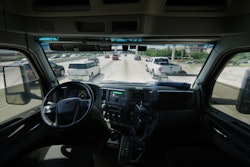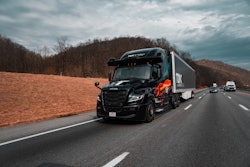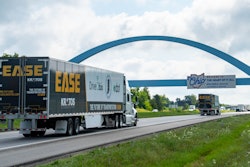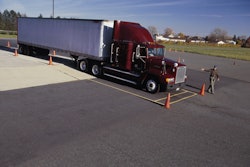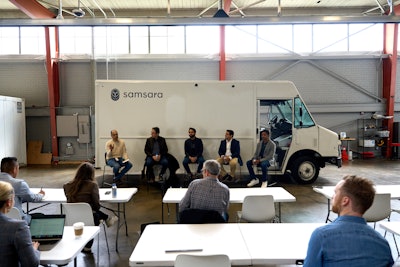
Automation has been around for centuries, but its popularity in logistics is more recent with many challenges preventing wide-scale adoption.
Gautam Narang, CEO and founder of the autonomous middle-mile trucking company Gatik, said the hype around autonomous vehicles was at its peak in 2017 when OEMs and automakers were promising there would be tens of thousands of AVs on the road by 2020.
“We joke about this at Gatik that somehow the promise of autonomy is always three to four years out,” Narang said during an autonomy roundtable hosted in late April by Samsara at its R&D Innovation Hub in San Francisco.
Here we are in 2025, and mass adoption of AVs is still “just around the corner.”
But the pace at which technology has evolved over the last decade has picked up, and Narang said he expects it to accelerate even further over the next five years.
Much of that is to the credit of AI.
Narang said the core technology around autonomy is becoming more data driven, and AI is driven by data. Boris Sofman, the former senior director of engineering, head of trucking, at Waymo, said AI is able to capture the most subtle nuances of human-like behavior and interactions in ways that could never be engineered, and it’s helping to expedite autonomous operations.
“Traditional robotics might have been driven by heuristics and search algorithms, and optimized with some engineered solutions. You just can't do that with some of the most complex problems,” Sofman said. “When you shift to these data-driven approaches, you're a lot better at absorbing more and more capability and capturing those subtleties – even if you don't know exactly what those signals are internally – and generalizing becomes easier and easier where you're effectively using data to explain whatever gaps you might have.”
Safely operating AVs
A key factor urging autonomy in logistics operations is labor shortages, especially when it comes to commercial drivers, said Samsara CEO Sanjit Biswas. With an aging workforce and very few people lining up to take on the job, autonomous vehicles are needed to help fill that gap.
But it has to be done safely, and safety – as well as the perception of safety – is one of the biggest challenges in AV adoption.
Gatik, which runs light- and medium-duty AVs on repeatable routes, recently received certification to operate AVs without safety drivers. Narang said when the company first put an AV on the road without a driver, people in other cars were hanging out their windows taking pictures, which obviously creates a safety concern beyond a vehicle with no driver.
Gatik provides access to an independent third-party safety auditor and undergoes a comprehensive and rigorous safety assessment. The auditor looks beyond just the operation of the business to how the system is actually designed, from the development of the technology and algorithms to the software and hardware.
If there are any anomalies, Gatik’s system is either able to predict or detect that based on trigger MRCs (minimum risk conditions), Narang said.
“The level of performance should be better than a human driver and close to perfection, but our belief is there is no zero-risk condition,” he said. “The way we go about our safety framework is we get all the different stakeholders (together) to define what is that acceptable risk.”
Sofman said there are many safety challenges for AVs, especially in urban driving areas, where there are complex interactions with pedestrians, cyclists, cars, intersections, construction zones, etc.
“You have a really adversarial kind of a situation where you're measured by the worst-case performance, not the average case performance … and that drives a completely different type of development,” he said. “You think the hardest part is the autonomy development, (but) as you get better and better and you get closer to driverless, you realize that finding a way to actually evaluate your system and qualify it and make it so that when you're right on the edge of driverless and you find a problem that, in fixing it, you didn't create 15 other (problems) in that space.”
The autonomous future
Narang said the future of AVs will not be conquered by a single entity. Many companies set out on solo missions to create the technology, but Gatik focused on the customer – first solving the use case of the business model and then approaching the technology.
Gatik works with two OEMs and partners with another company for maintenance so it can focus on its relationships with its retail customers. The goal, Narang said, is to own the customer relationship and remain asset and operationally light.
He believes that is the future of AV operations: partnerships.
“Level four at scale, we believe, is a partnership-heavy industry,” Narang said. “No one company can do everything alone … For us, it was very important to focus on what we are good at and then partner with the best for everything else.”




